Highlighting a bleak future in the wake of the unchecked use of pesticides, Rachel Carson’s landmark book Silent Spring (1962) raised awareness of the vulnerability of nature and our dependence on it and motivated many people to become active in environmental protection. Possibly less well known is the sense of wonder in nature that inspired her, a wonder that stirs joy and a sense of mystery in children and adults alike
In her book, The Sense of Wonder, she wrote: “Those who contemplate the beauty of the earth find reserves of strength that will endure as long as life lasts.” The book stemmed from an essay she wrote as a guide to adults introducing children to nature, and she herself delighted in sharing her joy in nature with children.
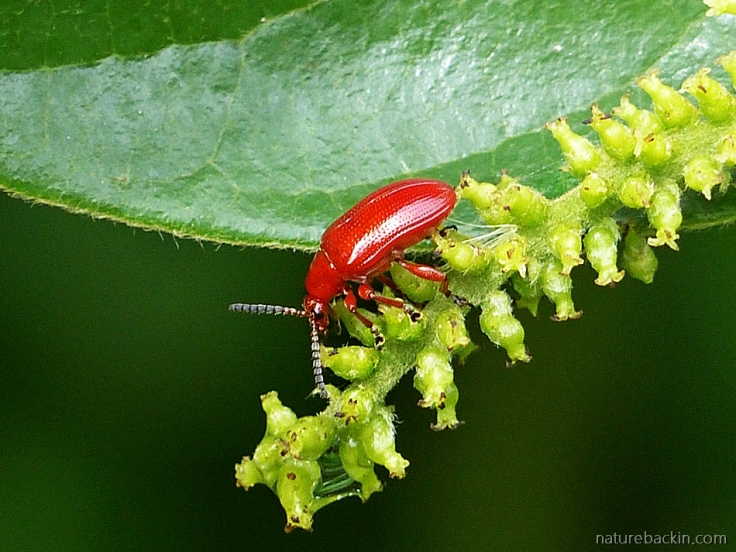
By my simply standing and staring I discovered this tiny scarlet insect feeding on a tree in our garden. To experience such wonder by doing so little can feel somewhat transgressive, trained as we are to be busy in order to gain reward
Rachel Carson’s book on wonder, published in 1964, remains pertinent today when even more children are likely to be nature-deprived now than there were then. As Carson observed: “A child’s world is fresh and new and beautiful, full of wonder and excitement. It is our misfortune that for most of us that clear-eyed vision, that true instinct for what is beautiful and awe-inspiring, is dimmed and even lost before we reach adulthood.”
I am sure that I am not the only adult who remembers as a child spending hours lying on the ground observing ants and other insects going about their business? Taking photographs for this blog has encouraged me to spend time cultivating this ability to observe small things, shift the level of my perception to another level and I am frequently amazed by what I find. I don’t have to travel far beyond my back door to explore into an unknown realm.

In my quest to enter into the kingdom of tiny, winged things, albeit only as an uninvited observer, I am finding new ways of looking at creatures I thought were familiar
Carson tied her sense of wonder to her concerns about our mistreatment of nature: “The more clearly we can focus our attention on the wonders and realities of the universe about us, the less taste we shall have for destruction.”
Including even those of us who have been in the habit of reflexively reaching for the insecticide spray, I hope that when we see insects we can pause and wonder at their intricacy, their beauty in form and flight, and reflect on their lives and how they live, and question why we think we can eradicate them without giving it a thought.
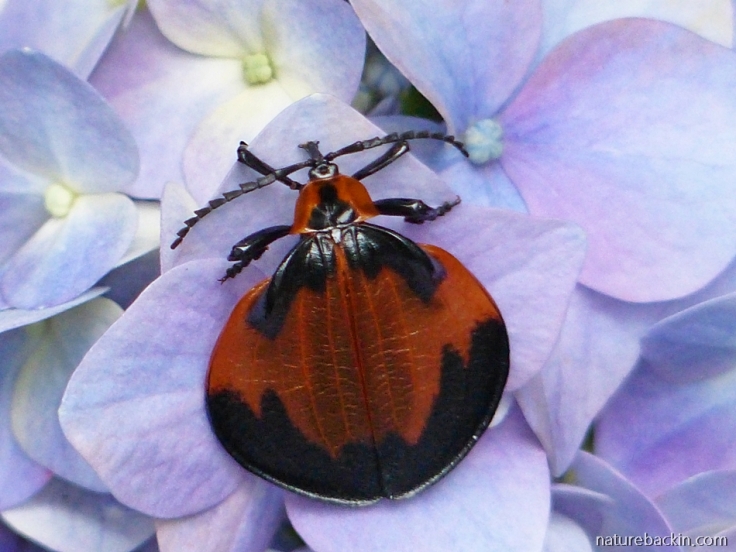
Is this not a wonderful creature?
In the past few months there has been media coverage of recent studies reporting on declining insect populations, studies that give rise to anxiety about an “insect apocalypse” leading to a catastrophic collapse in eco-systems and a ultimately a devastating effect on us. Studies on declining insect populations take place in discrete locations and most of the studies reported on took place in Europe and North America, and they cannot be seen to be representative of the entire world. It is clear that more and ongoing work is necessary and more funding is required. However, significant declines in insect numbers at least in specific regions are not disputed, and such trends are extremely worrying even if not at apocalyptic levels.
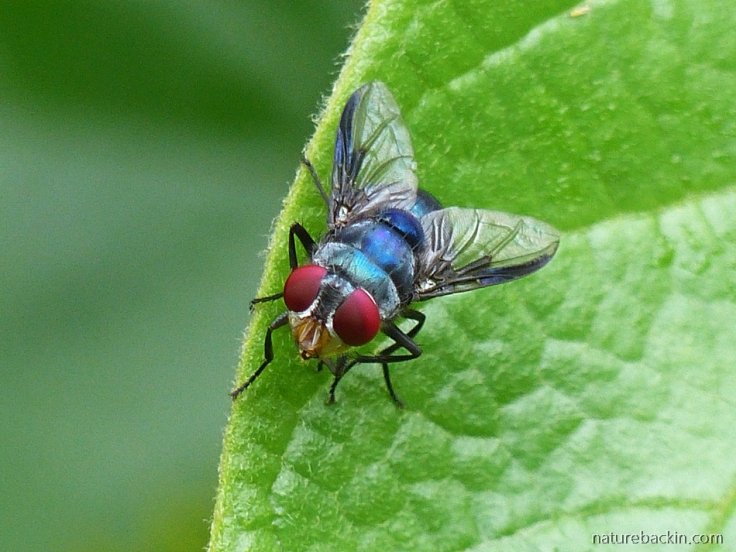
An adult blow fly resting after feeding on nectar
Much about insects and their diversity is as yet unknown, so we don’t have a documented baseline against which to measure change. It is known though that insects are fundamental to functioning ecologies. Insects act as plant pollinators, including of many food crops that feed people. Many birds, reptiles and other animals depend on insects as their main or only food source, and animals higher up the food chain depend on the animals that depend on the insects. Insect species also predate on other species of insects, keeping numbers in check. Insects, such as ants, are crucial in aerating the soil enabling it to absorb rain and other nutrients. Without insects, corpses, dung and other decomposing organic material would not efficiently break down.
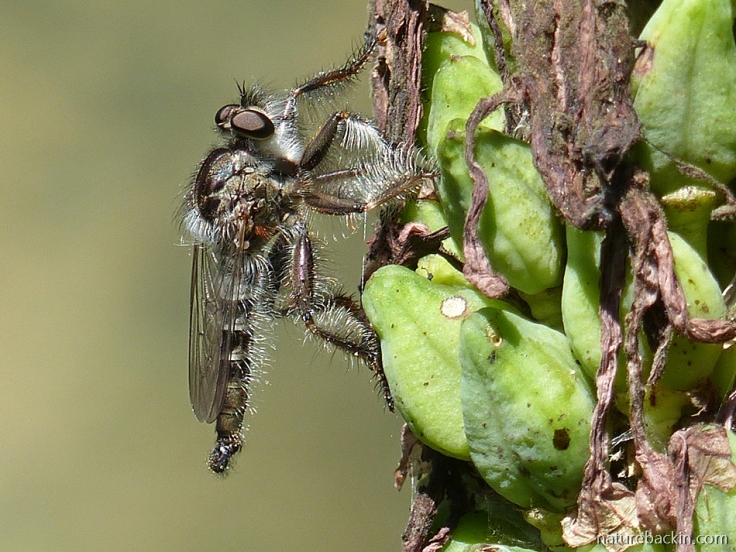
An impressive robber fly, an efficient predator of other insects
Reasons for declining insect numbers are numerous and widespread and include the loss and degradation of habitats, the extensive use of pesticides particularly in commercial agriculture, the pollution of air and water, disrupting factors such as light pollution, the spread of insect diseases, and climate change

Another species of an insect that predates on other insects is this rather gorgeous assassin bug
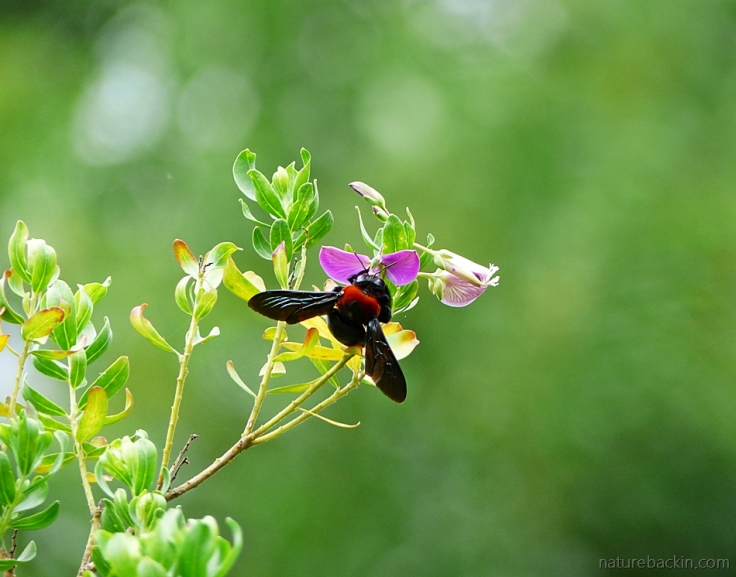
One of the more obvious pollinators around – a carpenter bee
Given the concerns about consequences of declines in insect populations, perhaps there might be a shift in public perceptions of insects. Often at best insects are viewed as a nuisance, perhaps when faced with the possibility of losing them we might understand that they are beneficial not only as indicators of environmental health but that they are fundamental to the survival of other forms of life.
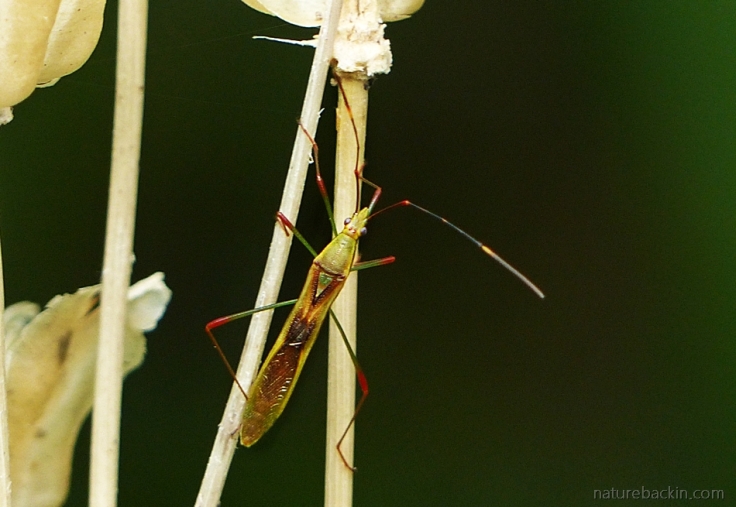
Whether we label them as beneficial or not, there is no denying that insects are fascinating in their uniqueness and in their diversity
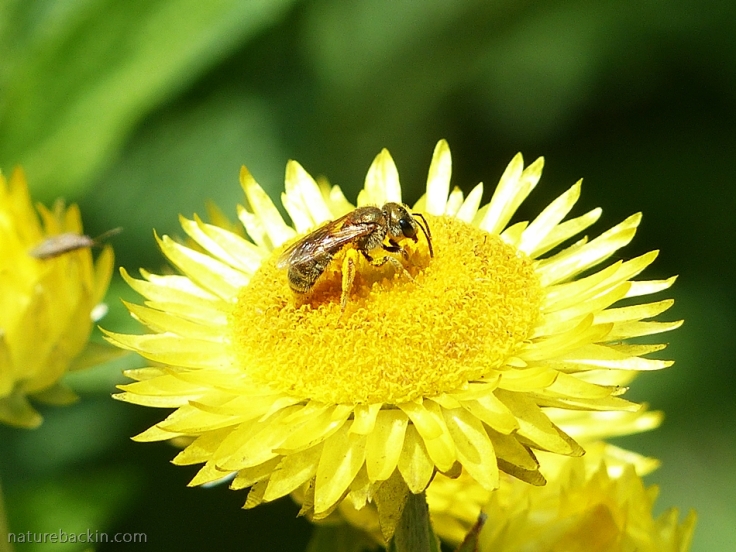
A solitary bee coated with pollen on the flower of a yellow everlasting
Suburban areas have the potential to provide green corridors and havens for insects and other urban wildlife. Many insects have evolved to have close relationships with specific plants. We can plant – or simply encourage – a diversity of plants in our gardens, parks and road verges and these plants should include as many native plants as possible. Attracting insects to our gardens in turn attracts insect-eating birds – without the insects these birds would starve.
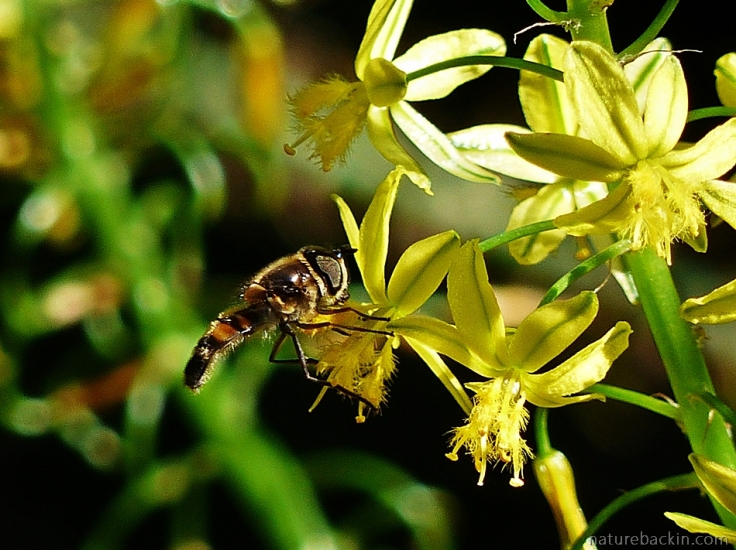
A hoverfly attracted to the flowers of a species of bulbine in our garden
Many species of insects depend on native plants to enable them to reproduce. For example, although adult butterflies may be able to eat nectar from a variety of plants, many species lay their eggs only on specific native plants that are described as being hosts to the butterfly larvae (caterpillars). As gardeners we should be pleased to host the hosts and delighted to see the butterfly larvae munching the leaves of host plants. Such munching has no adverse effect on the health of the plant, and the caterpillars eventually metamorphosis into the butterflies we all seem to enjoy gracing our gardens.
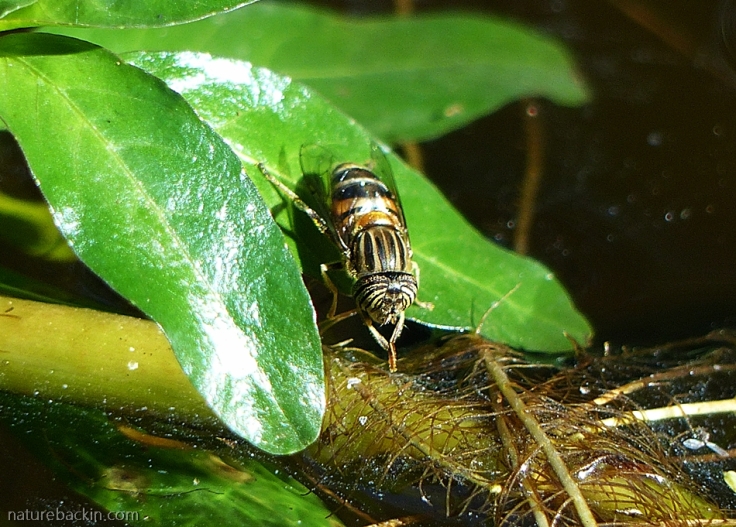
Another species of hoverfly, this one drinking from our garden pond. Birdbaths and ponds benefit insects as well as birds
A garden with a diversity of plants is likely to attract a diversity of insects and birds, which in turn will naturally keep numbers in check. If we use insecticides it interrupts this food chain – we kill the insects that predate on other insects and we deprive the birds that eat insects of their food supply. By using poisons we destroy the functioning of a diverse eco-system. By planting native plants, not using insecticides and generally encouraging diversity and following wildlife-friendly practices we can add to a collective contribution to making a positive difference that promotes life.
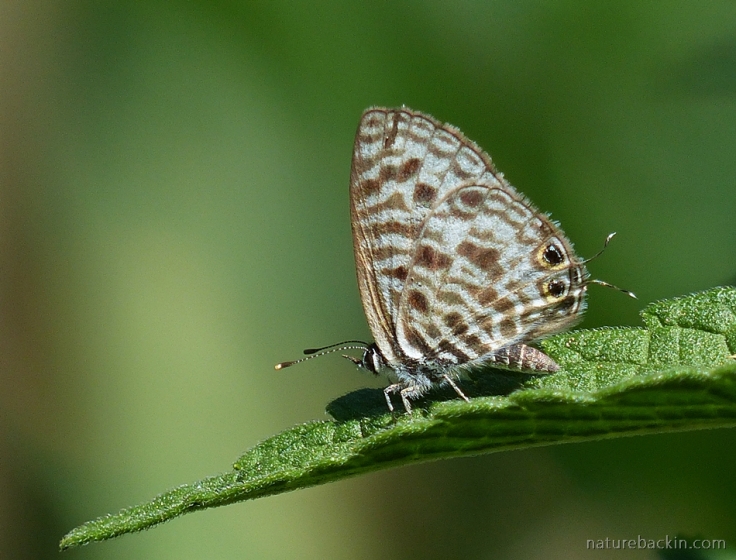
Shifting ones perspective, to notice and enjoy smaller forms of life, to adopt a more relaxed approach to gardening allowing self-seeding native plants to flourish, to appreciating sharing such plants with other forms of life, it is encouraging to remember Rachel Carson’s observation: “Those who dwell, as scientists or laymen, among the beauties and mysteries of the earth, are never alone or weary of life.”
Sources:
Hoff, Mary. 2018. Insect Populations are Declining around the World. How Worried Should We Be? Ensia. October 30. https://ensia.com/features/insects-decline-armageddon-biodiversity/
Temple, Stanley A. 2015. Rachel Carson and a Childhood Sense of Wonder. Fellows Forum. Wisconsin Academy. https://www.wisconsinacademy.org/magazine/rachel-carson-and-childhood-sense-wonder
Young, Ed. 2019. Is the Insect Apocalypse Really Upon Us? Claims that insects will disappear within a century are absurd, but the reality isn’t reassuring either. The Atlantic, Feb 19. https://www.theatlantic.com/science/archive/2019/02/insect-apocalypse-really-upon-us/583018/
Posted by Carol









March 18, 2019 at 4:40 am
We’ve been busy at our attempt at eradicating invasive plants and planting natives. We’re already seeing an increase of birds. It’s such a joy to see the yard coming alive again. The only difficulty is that I’ve been taking so many bird portraits that it’s becoming an overwhelming task to sort through them all. I can certainly think of worse problems however! 😏
LikeLiked by 1 person
March 18, 2019 at 3:06 pm
How lovely that your plantings are benefiting the birds (and other creatures too) and in turn you are benefiting as well! I look forward to seeing some of your bird portraits.
LikeLike
March 19, 2019 at 8:34 pm
Seems like it’ll always be a work in progress. We’re starting from cuttings or seeds for the most part, so patience will be the key word.
LikeLike
March 18, 2019 at 12:57 am
Excellent photos!
I’ve read that studies in Europe, Canada, and the United States have shown that DDT didn’t cause the human diseases Carson had claimed. The World Health Organization reinstated DDT in 2006 as part of its effort to eradicate malaria because millions have died from malaria since DDT was banned.
Sober second thought suggests that it was reasonable to ban DDT for agricultural use, but it probably should not have been eliminated for public health use.
LikeLiked by 1 person
March 18, 2019 at 3:18 pm
Thanks Margy. Here in South Africa DDT is routinely used to spray the inside of dwellings in malaria areas. I think you read the article in the Daily Beast perhaps? Unfortunately the discussions around DDT are often polarised. Here is a good brief summary on DDT: https://www.epa.gov/ingredients-used-pesticide-products/ddt-brief-history-and-status
And here are two more detailed and interesting pieces on ‘Silent Spring’ 50 years on:
https://jmvh.org/article/ddt-and-silent-spring-fifty-years-after/
2012
https://www.eea.europa.eu/ds_resolveuid/FH1968AISY
2015
And you might be interested in recent research projects spanning 5 decades on the relationship between breast cancer and DDT:
https://academic.oup.com/jcem/article/100/8/2865/2836085
2015
https://consumer.healthday.com/cancer-information-5/breast-cancer-news-94/breast-cancer-and-ddt-timing-of-exposure-may-matter-742666.html
2019
There is also a very touching tribute to Carson in ‘The New Yorker’:
https://www.newyorker.com/magazine/2018/03/26/the-right-way-to-remember-rachel-carson
LikeLike
March 18, 2019 at 5:12 pm
Yes, I’ve read most of those links. Discussions about just about everything are polarized and there are probably ‘the world is overpopulated’ advocates who don’t find malaria deaths all that problematic! There are no easy answers.
LikeLike
March 17, 2019 at 11:27 pm
Amazing post. Stunning photographs. Thank you for allowing me to find you.
LikeLiked by 1 person
March 18, 2019 at 3:04 pm
Thank you very much Michael.
LikeLike
March 17, 2019 at 3:45 am
A very timely and informative post. Lovely photos too. Do you know what the scarlet bug and the truly ‘wonderful creature’ are?
LikeLiked by 1 person
March 17, 2019 at 8:14 pm
Thank you Graham. I think that the scarlet one is a type of leaf beetle, and the ‘wonderful’ one is one of the netwing beetles.
LikeLiked by 1 person
March 18, 2019 at 7:12 am
The netwing beetle is stunning. Such fabulous variety in the insect world.
LikeLike
March 16, 2019 at 12:35 am
Your photos are superb, Carol!
LikeLiked by 1 person
March 17, 2019 at 8:11 pm
Thanks very much Eliza.
LikeLike
March 15, 2019 at 11:14 pm
Excellent post – content and photos!
LikeLiked by 1 person
March 17, 2019 at 8:09 pm
Thank you Belinda. I hope your weather improves soon so you can be out and about with your camera!
LikeLiked by 1 person
March 17, 2019 at 10:05 pm
Thank you Carol!
LikeLiked by 1 person
March 15, 2019 at 10:22 pm
Wow, these pictures are amazing! May we take much better care of all the tiny little creatures!
LikeLiked by 1 person
March 17, 2019 at 8:08 pm
Thanks very much. That is my hope too.
LikeLiked by 1 person
March 15, 2019 at 12:01 pm
Lovley insects.
LikeLiked by 1 person
March 17, 2019 at 8:08 pm
Thanks Sherry. I hope that more people learn to appreciate them!
LikeLike
March 15, 2019 at 10:33 am
Beautiful post, both words and pictures. And a message I strongly endorse. All of us – adult and child alike – need to stop and stare. When we have seen for ourselves the marvels of the insect world, there on our doorsteps, the wonder and fragility of life becomes all the more precious.
LikeLiked by 1 person
March 17, 2019 at 8:06 pm
Thanks Sandra. Hopefully more of us will be able to become aware of the wonder, fragility and preciousness of life in all its diversity.
LikeLiked by 1 person
March 15, 2019 at 8:25 am
In Germany we have a big decline of insects. You can’t ignore that anymore.
And it is good to know that more and more people are taking to the streets to protest against glyphosate and other pesticides. All this is destroying biodiversity and ultimately threatening our livelihoods.
You made great macro pictures, dear Carol! Great informative post!
LikeLiked by 1 person
March 17, 2019 at 8:03 pm
Thank you Simone. I heard about that German study on declining insect numbers. Very sobering, but let’s hope that public opinion continues to swing in favour of biodiversity and environmental protection and that agribusiness starts shifting to less harmful practices.
LikeLiked by 1 person
March 15, 2019 at 7:04 am
Watching my small grandson’s absorption when he has the chance to spend time looking at any small insect he notices is instructive. But our time in rural France really taught me to stand and stare, as insect life is still so rich there – far more so than here. Long may that be the case for them.
LikeLiked by 1 person
March 17, 2019 at 7:58 pm
How special to learn from your grandson’s attentiveness and how lovely for him to have the company of an interested adult during such explorations. I also hope that rural France is able to retain its special character and diversity. Sad that so much has been lost in the UK (and elsewhere).
LikeLike
March 15, 2019 at 5:51 am
Dear Carol I too love the small creatures I encounter everytime I take time to stop and stare! Thank you for your beautiful blog, a sense of joy and wonder is indeed a life changer! xxx
LikeLiked by 1 person
March 17, 2019 at 7:54 pm
Thanks Christeen – it would be nice if more people are able to better connect with nature in their daily lives and experience the sense of wonder.
LikeLiked by 1 person
March 15, 2019 at 1:52 am
I echo what Dries has said and salute you for a well-constructed post. I too find that blogging has opened a new realm of observation right here in my garden and am in awe of what I come across daily in this space.
LikeLiked by 1 person
March 17, 2019 at 7:51 pm
Thank you Anne. Yes, it is awesome what we can find under our noses when we get in the habit of looking.
LikeLike
March 15, 2019 at 1:11 am
Even before commenting on the content I really have to give you a standing ovation for your brilliant macro-photography skills, Carol! The photos illustrating this post is excellent in the extreme!
I have a few guide books on our South African insects, and still I am not able to identify even to family level 3-quarters of the insects I encounter on a daily basis in our garden, never mind out in the field.What a fascinating world is revealed when we bend the knees and train our eyes on a narrower focus. Yesterday for instance I must admit spending a bit more time in the bathroom at work, just to watch hundreds of tiny ants taking apart a large moth “carcass”… 😀
LikeLiked by 4 people
March 17, 2019 at 7:46 pm
Thank you so much. I use a bridge camera and as its close focus does not work so well, these are “cheat” macros as I take them using the zoom. Some of them are a bit grainy but I figure the subject is interesting nevertheless.
Insects are so numerous and various identifying them is not easy, and sometimes its good just to marvel at them anyway. I fully understand your spending time watching the ants 🙂 I think we do have to train the eye to a narrower focus as you describe it. Often one does not need to bend the knees as its amazing how many insects one can spot in the vegetation at eye-level.
LikeLiked by 1 person
March 14, 2019 at 10:55 pm
Your images are incredible, Carol. You really capture the diversity and beauty of insects.
LikeLiked by 2 people
March 17, 2019 at 7:40 pm
Thank you Sandy. It is eye-opening to take the time to look for the tinier forms of life.
LikeLiked by 1 person
March 17, 2019 at 7:42 pm
Yes, we miss so much.
LikeLiked by 1 person
March 17, 2019 at 7:48 pm
Absolutely we do, but tantalizing to know what a richness there is out there, even if it remains unseen by us.
LikeLiked by 1 person